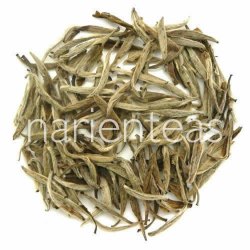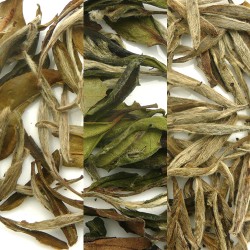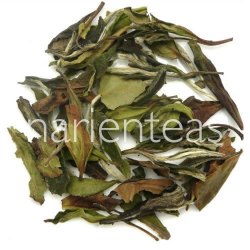- Brewing & Distilling
- Caffeine Free
- Culinary
- Fair Trade
- Medicinal
- Organic
- Sprouting Seeds
- Tisane
- Viable Seeds
- Wildcrafted
Free Shipping $49+
December Discount 10%
White Tea
White teas are uncured and unfermented young tea leaves and buds. They are usually dried quickly to prevent oxidation.
New to loose white teas? Try our White Tea Sampler
Light and ethereal, deceptively complex, white tea is a very special form of tea.
This is as close to the tea from the legend of Shen Nung that you will find. It is said that in 2737 BC, a tea leaf drifted from a tea tree into his cup of hot water. White tea is that same simple leaf, dried. White tea brings you back to the dawn of tea.
White tea flavors tend to be light and gentle. White teas have been described to have flavors and aromas that include honeysuckle, maple, orange, lemon, or floral like jasmine and rose. Because the "new style" leaf white teas have a bit more oxidation than bud-style, their flavor profile may lean more towards that of an oolong or even a black.
For many white tea harvests, only the buds are harvested. For the "new style" whites, buds and the first one or two leaves are plucked.
There are three primary forms of white tea:
- Classic White Tea - This is the extraordinary Silver Needle or "Bai Hao Yinzhen", which is composed only of closed buds harvested in China's Fujian region. One particularly noticeable characteristic of the bud teas are that the buds are covered with soft downy hairs called tricomes. These tricomes protect the buds from sun and insects.
- Bud-Style White Tea - This tea is composed of closed buds harvested from other parts of China, such as the Anhui Province, or from other countries, like India, Sri Lanka, and even Kenya.
- New Style White Tea - These teas include both bud and leaf, but are processed as other whites are. Our White Peony or "Bai Mu Dan", is a well-known example of this type. Our Drum Mountain White Cloud from the Northern Fujian Province is another.
Like Gyokuro green teas, plants intended for white tea processing are shaded for the last 3 weeks before the harvest.
White teas are often dried in the shade with no additional heat provided. Other times they are dried in the sun or in a temperature-controlled room. The pale green buds turn to a silvery color as they dry. Because there is no heat applied to destroy the enzymes, some oxidation does occur during the drying process, particularly in the "new style" white teas that include opened leaves. Sometimes white teas are shaped, but most are not.
Brewing White Tea
White tea, by virtue of its size, can be hard to measure accurately for brewing with spoon measurements. It is more accurate to use weight. Use 2-3 grams (approximately 2 tbs) of white tea per 6 ounces of water at 160-175 degrees Fahrenheit for 3-4 minutes.The caffeine content of teas depends upon many factors: the cultivar of the tea plant, the age of the leaf being picked, and where on the stem the leaf is located, how long it is oxidized, leaf size, how much leaf is used, the temperature of brewing, and how long the tea steeps.
Studies have shown that one pound of tea leaves has more caffeine than one pound of coffee. However, it takes less tea than coffee to brew a cup. Therefore, there is 50-65% less caffeine in a cup of tea than in a cup of coffee. Plus, the way the caffeine is absorbed is different. With tea, the caffeine is absorbed more gradually so you tend not to get the big caffeine burst nor the caffeine crash.
The buds of the tea plants are thought to contain the highest concentration of caffeine in order to protect them from being consumed by predators. Since the tea is simply dried, white tea, particularly bud-style white tea, has a high caffeine content relative to other teas. However, the fact that white tea is steeped at a lower temperature than many other teas lowers the amount of caffeine that is actually released into the cup. The overall effect is a cup that has less caffeine than black tea and a more similar amount of caffeine to green tea.


